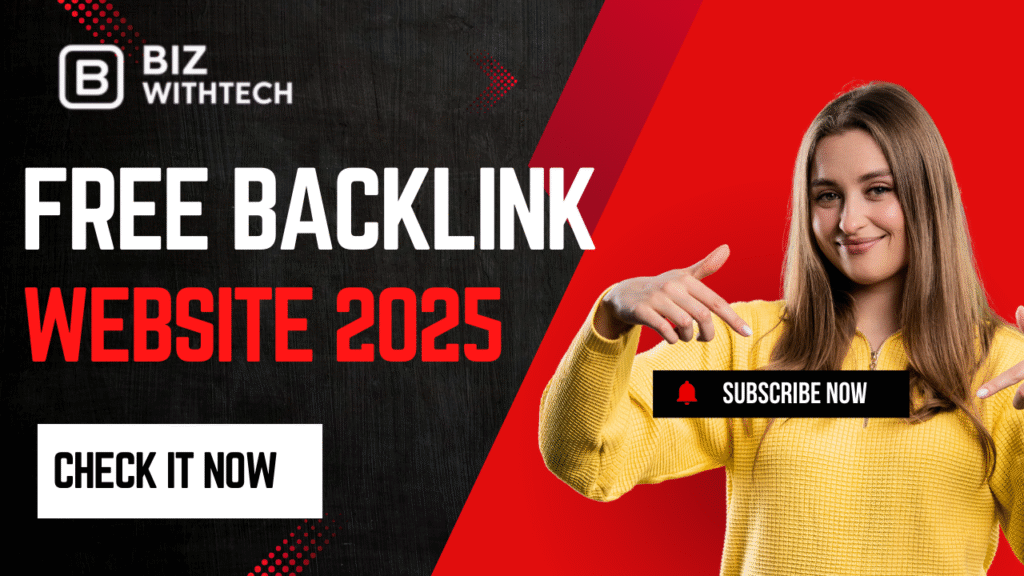In the competitive world of search engine optimization, understanding and optimizing your Click-Through Rate (CTR) can be the difference between a website that merely ranks and one that actually drives traffic and conversions. Let’s dive deep into what CTR means for SEO, why it matters, and how you can improve it.
Understanding CTR: The Basics
Click-Through Rate (CTR) is a metric that measures the percentage of people who click on your link after seeing it in search results. The formula is straightforward:
CTR = (Total Clicks / Total Impressions) × 100
For example, if your page appears in search results 1,000 times and receives 50 clicks, your CTR is 5%.
While this sounds simple, CTR is one of the most revealing metrics in SEO because it tells you how compelling your search listing is to real users. You can rank #1 for a keyword, but if nobody clicks on your result, that ranking delivers zero value.
Why CTR Matters for SEO?
1. Direct Traffic Impact
The most obvious benefit of a high CTR is increased traffic. Even if you’re ranking in position 3 or 4, an optimized listing with a compelling title and description can outperform the #1 result if users find your listing more relevant or appealing.
2. Potential Ranking Signal
While Google has given mixed messages about whether CTR directly influences rankings, many SEO professionals believe that user behavior signals, including CTR, play a role in how Google evaluates search result quality. The logic is simple: if users consistently choose your result over others, it signals that your page may be more relevant for that query.
3. Performance Indicator
CTR serves as a diagnostic tool. A low CTR despite good rankings suggests problems with your title tags, meta descriptions, or how your content aligns with search intent. It’s your canary in the coal mine for content-market fit.
4. Competitive Advantage
In crowded SERPs (Search Engine Results Pages), a high CTR means you’re capturing more of the available traffic, leaving less for your competitors—even those who may rank higher than you.
What’s Considered a “Good” CTR?
CTR varies significantly based on several factors:
By Position:
- Position 1: 25-35% average CTR
- Position 2: 15-20%
- Position 3: 10-15%
- Positions 4-10: 5-10%
- Position 11+: Under 2%
By Industry and Query Type:
- Branded searches typically have much higher CTRs (often 40-60%)
- Commercial intent keywords may have lower CTRs due to ad competition
- Informational queries often have higher organic CTRs
By SERP Features: Featured snippets, local packs, knowledge panels, and other SERP features can dramatically impact CTR by either stealing clicks or pushing organic results down.
Factors That Influence Your CTR:
1. Title Tags
Your title tag is the most prominent element users see in search results. An effective title should:
- Include your target keyword (preferably near the beginning)
- Be compelling and create curiosity
- Match search intent
- Stay within 50-60 characters to avoid truncation
- Include numbers, dates, or power words when appropriate
Example:
- Weak: “Information About Dog Training”
- Strong: “Dog Training 101: 7 Proven Methods That Work in 2025”
2. Meta Descriptions
While meta descriptions don’t directly impact rankings, they significantly influence CTR. An optimized meta description should:
- Provide a clear value proposition
- Include relevant keywords (Google bolds matching terms)
- Create urgency or highlight benefits
- Include a call-to-action
- Stay within 150-160 characters
3. URL Structure
Clean, readable URLs inspire more trust than long, parameter-filled ones. Users are more likely to click on “example.com/seo-guide” than “example.com/p?id=12345&cat=seo.”
4. Rich Snippets and Schema Markup
Structured data can help your listings display enhanced features like:
- Star ratings and reviews
- Product prices
- Recipe information
- FAQ sections
- Event dates
- Author information
These visual enhancements make your listing stand out and can significantly boost CTR.
5. Brand Recognition
Well-known brands naturally enjoy higher CTRs. Users trust familiar names, which is why building brand authority should be part of your long-term SEO strategy.
6. Search Intent Alignment
Understanding what users actually want when they search for a keyword is crucial. If your title and description don’t clearly indicate you’ll fulfill their intent, they’ll skip your result.
How to Monitor Your CTR
Google Search Console
Google Search Console is your primary tool for tracking CTR. Here’s how to use it:
- Navigate to the Performance report
- View clicks, impressions, average CTR, and average position
- Filter by specific pages, queries, countries, or devices
- Identify pages with high impressions but low CTR (prime optimization opportunities)
Key Metrics to Track:
- Overall account CTR trends
- CTR by individual query
- CTR by landing page
- CTR by position
- CTR changes over time
Proven Strategies to Improve Your CTR
1. Optimize for Search Intent
Before writing anything, understand what users want. Are they looking for information, trying to buy something, or searching for a specific website? Your title and description should immediately signal you have what they need.
2. Use Emotional Triggers
Certain words and phrases naturally increase clicks:
- Numbers (“7 Ways,” “Top 10”)
- Current year (“2025 Guide”)
- Power words (“Ultimate,” “Essential,” “Proven,” “Secret”)
- Brackets and parentheses (“[Updated],” “(Free Template)”)
- Questions that resonate with searcher concerns
3. Create Compelling Titles Without Clickbait
There’s a fine line between compelling and misleading. Your title should be enticing but must accurately reflect your content. Clickbait may increase CTR initially but will hurt you through high bounce rates and loss of trust.
4. Test Different Approaches
SEO isn’t one-size-fits-all. What works for one audience or keyword may not work for another. Consider:
- A/B testing different title formats
- Experimenting with different description styles
- Updating old content with fresh titles and dates
- Trying different angles for the same topic
5. Implement Schema Markup
Adding structured data helps search engines understand your content better and can earn you rich snippets. Focus on:
- Article schema for blog posts
- Product schema for e-commerce
- FAQ schema for comprehensive guides
- Review schema where applicable
- How-to schema for tutorials
6. Stand Out from the Competition
Review what your competitors are doing in the SERPs and differentiate yourself:
- If everyone is using similar titles, try a different angle
- Offer something extra (templates, tools, downloadables)
- Highlight unique qualifications or data
- Use more specific, detailed titles
7. Optimize for Featured Snippets
Position zero often captures a significant portion of clicks. To optimize:
- Answer questions clearly and concisely
- Use proper heading structure
- Include lists and tables where appropriate
- Provide direct, comprehensive answers
8. Keep Content Fresh
Adding the current year or “Updated” to titles signals relevance. Regularly updating popular content and refreshing its title and description can give CTR a boost.
👉 Want to learn step by step how to improve your CTR? Watch our video for a detailed walkthrough!
🎥 Click here to watch now and start optimizing smarter.
Common CTR Mistakes to Avoid
- Keyword Stuffing: Unnatural, repetitive titles turn users off and may look spammy
- Vague Descriptions: Generic text that could apply to any page won’t convince anyone to click
- Ignoring Mobile: With mobile-first indexing, ensure your titles and descriptions work well on small screens
- Mismatched Content: If your title promises something your content doesn’t deliver, users will bounce immediately
- Neglecting SERP Features: Not optimizing for featured snippets, local packs, or other features means missing opportunities
The Relationship Between CTR and Other SEO Metrics
CTR doesn’t exist in a vacuum. It interacts with other important metrics:
Bounce Rate: A high CTR with a high bounce rate suggests your title is misleading or your content doesn’t match expectations.
Dwell Time: Users who click through and stay longer signal content quality to search engines.
Conversion Rate: Traffic is meaningless without conversions. Optimize CTR while ensuring the traffic is qualified.
Rankings: Improved CTR may contribute to better rankings over time, creating a positive feedback loop.
Advanced CTR Optimization Techniques
1. Analyze Competitor Listings
Search for your target keywords and study the top results. What words do they use? What formats work? What gaps can you fill?
2. Leverage FOMO and Scarcity
When appropriate, phrases like “Limited Time,” “Exclusive,” or “Before It’s Gone” can increase urgency.
3. Use Dynamic Insertion
For paid ads, dynamic keyword insertion is common. While you can’t do this exactly in organic SEO, you can create highly targeted pages for specific keyword variations.
4. Monitor and Adapt to SERP Changes
Google constantly tests new SERP features. Stay aware of what’s appearing for your target keywords and adjust your strategy accordingly.
5. Target Long-Tail Keywords
These often have less competition and users with these specific queries may find your targeted title more relevant, leading to higher CTR.
Conclusion
Click-Through Rate is a critical metric that bridges the gap between rankings and actual traffic. While achieving high rankings remains important, optimizing your CTR ensures you maximize the value of those rankings. By crafting compelling titles, writing persuasive descriptions, implementing schema markup, and continuously testing and refining your approach, you can significantly improve your CTR and drive more qualified traffic to your website.
Remember, SEO success isn’t just about being found—it’s about being chosen. In a world where users have countless options at their fingertips, your ability to stand out in the SERPs and convince users to click can be your greatest competitive advantage.
Start by auditing your current CTR performance in Google Search Console, identify your biggest opportunities, and implement these strategies systematically. Small improvements in CTR can lead to substantial increases in traffic and, ultimately, conversions.




